Convector radiator: principle of operation, mounting
The hit parade of the most economical and efficient heaters is headed by a convector water radiator. Thanks to the original design, the air in the room heats up quickly and, most importantly, does not burn oxygen. The ergonomic design and the ability to place the device anywhere in the room give it a special appeal.
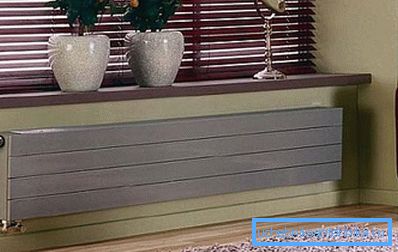
Principle of operation
According to some design features and principle of operation, convector-type water radiators differ from conventional batteries. For the manufacture of heating tubes of the convector, copper with a heat transfer coefficient of 410 W / m2 was selected, the casing and heat-conducting plates were made of aluminum, respectively, 220 W / m2.
The design of the device is a vertical row of aluminum plates encased in a case, threaded with a certain step on horizontal copper tubes. The secret lies precisely in the space between the plates, where as a result of the difference in air pressure, a maximum vertical thrust is created.
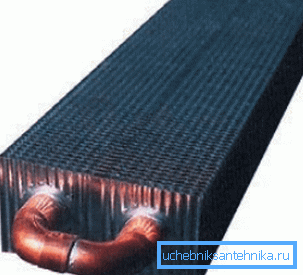
Due to a certain distance between the plates, the air moves in a spiral and gets warmer much faster than if it would rise in parallel streams. Cold air that has more pressure is literally sucked into the heated inter-plate space with a lower pressure and displaces warm flows.
If a conventional radiator radiates heat, then a convector-type radiator in the literal sense of the word mixes air, accelerating the warming up of the room. The use of materials with different thermal conductivity, prevents local overheating and positive ionization, which adversely affects the nervous system.

Note! You can choose a model with a built-in fan, which accelerates the movement of air masses, or buy it. Well, if there is an air damper available, it will allow you to regulate the “pressure” of the air.
Some advertising
Operation of convectors in different conditions allows you to clearly identify its positive qualities:
- The possibility of mounting their own hands.
- Different color design allows you to create a harmonious ensemble with interior decoration.
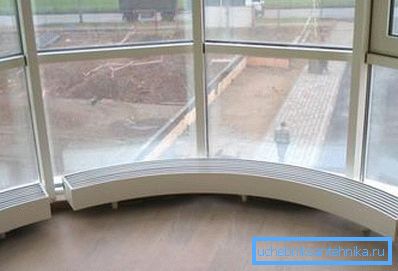
- Low weight.
- Easy maintenance.
- Uniform heating of the air - the difference between the floor and the ceiling is from 1 to 2 ° C.
- Saving electricity by heating a small amount of water.
- Temperature control thanks to built-in thermostat.
- The ability to create a controlled convector system at home.
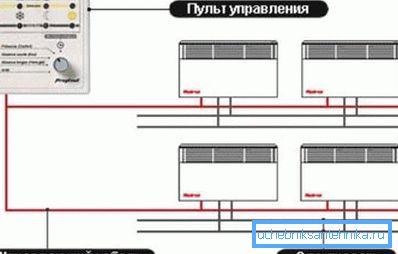
- Fireproof.
- Affordable price.
The disadvantages of the device include:
- The inefficiency of working in a room with forced ventilation.
- In a room with high ceilings warm air will stagnate at the top, not warming up at floor level.
- Dust due to the active movement of air masses.
In principle, you can cope with such shortcomings by observing elementary rules of hygiene and using the “survival rate” of devices anywhere in your apartment. By placing heating radiators of a convector type in a strategic place, one can use their abilities to the full.
Flour of choice
The choice is a responsible and pleasant thing at the same time. If we take the costs and time to connect to the heating system as a basis, an electric convector would be a good option. He does not burn oxygen, and connects elementary, and serves for a long time. But given the cost of electricity, it is necessary, figuratively speaking, to pay bills.
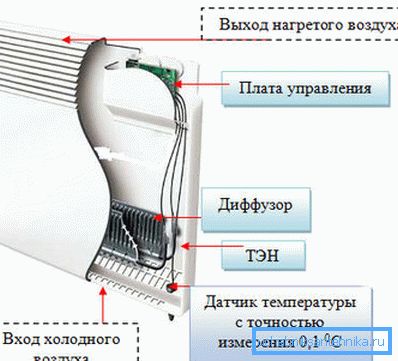
The question of which radiator is better than oil or convector requires an understanding of the inertia of the system:
- In a convector radiator, the heating medium of the heating system directly heats up the case, which immediately transfers heat to the space and the thermostat easily maintains the set mode.
- The oil battery is arranged differently: a reservoir filled with mineral oil and heating elements. Heating it will take place slowly in a certain order - heating elements, oil, body. The cooling of the internal volume of the oil also passes slowly and does not begin immediately after switching off. Thus, the oil cooler always works with some delay, even when using the thermostat.
Note! It's one thing to warm up with an oil battery in a small office space, another thing is to pay for his work from the family budget, which is a quarter more than for a convector.
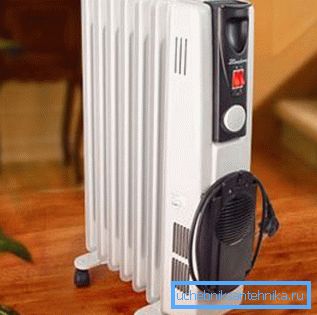
Variations of installation or types of convector radiators
Unlike radiators, which are mounted under window openings or on the wall, convectors can be mounted even in the floor.
By way of installation, convector radiators of water heating are divided into the following types:
- Wall - fastens everywhere where pipes "reach". The small weight of the device allows you to mount it even on plasterboard partitions, and compactness does not hurt to perform its functions as well as an impressive battery.
- Floor Ideal for rooms with panoramic windows. Elegant shapes and harmonious color will turn the device into a window element.
- Built in - his presence reveals perhaps pleasant warmth from under the baseboard or blowing through an elegant rectangular grid on the floor. Located in front of the door or window to the floor, the device will create a thermal curtain. In addition to home often used in offices, greenhouses, swimming pools.
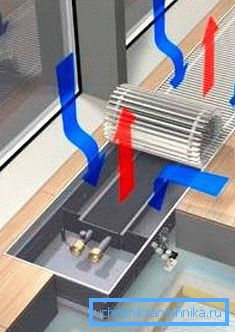
Installation Features
Convector-type floor and wall-mounted radiators are mounted by analogy with conventional batteries.
Installation of built-in models has a certain specificity and it is necessary to pay attention to the following points:
- Work carried out indoors.
- The heat exchanger on the side of the window will create a heat curtain, on the side of the room it will heat it.
- The distance between the niche and the window should be from 25 to 30 cm.
- First of all, the coolant and the electrical cable are fed into the niche for the heating convector.
- The device is installed strictly with the level of the floor (after filling) with the help of adjusting bolts.
- The distance between the walls of the niche and the convector case along the perimeter is recommended 1–1.5 cm.
- The device is fixed in a niche with cement mortar or assembly foam.
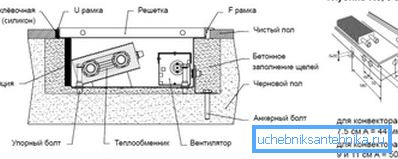
Such an instruction will help you do the work yourself, saving about 1500 rubles (the expert will take about 4,000).
findings
Convector heating radiators can serve as the main or additional source of heat. Aesthetic and safe they can be located both in the hall and in the nursery. Simple care and high efficiency will create a pleasant warm atmosphere in your home, and the structural features of some models will help to save usable space.
The video in this article shows the installation process of the floor convector.